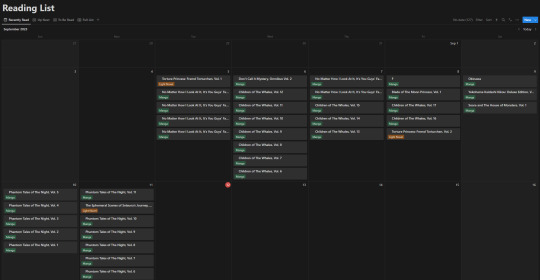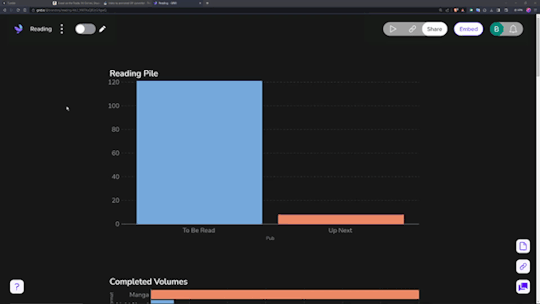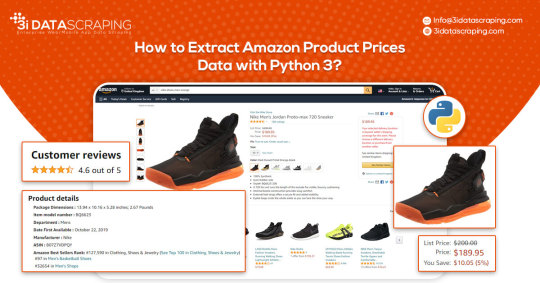#Amazon Price Scraper
Explore tagged Tumblr posts
Text
How Amazon Price Scraper Is Used To Scrape E-Commerce Data?

In the ever-evolving landscape of e-commerce, businesses are constantly seeking ways to gain a competitive edge. One such method gaining traction is web scraping, a technique used to extract valuable data from websites. Among the myriad of web scraping tools available, the Amazon Price Scraper stands out as a powerful instrument for extracting pricing information from the e-commerce giant, Amazon. In this blog post, we'll delve into the workings of the Amazon Price Scraper and explore how it is reshaping the way businesses gather crucial e-commerce data.
Understanding Amazon Price Scraper
Amazon Price Scraper is a specialized web scraping tool designed to extract pricing data from Amazon product listings. It works by accessing the HTML code of Amazon's web pages and systematically retrieving information such as product prices, availability, ratings, and more. This data can then be analyzed to gain insights into market trends, competitor pricing strategies, and consumer behavior.
How It Works
The Amazon Price Scraper employs a combination of web crawling and data extraction techniques to navigate through Amazon's vast repository of product listings. Here's a simplified overview of its operation:
URL Input: The user provides the Amazon Price Scraper with the URLs of the target product pages or categories they wish to scrape.
Web Crawling: The scraper begins by visiting the specified URLs and systematically traversing through the web pages, following links to additional product pages if necessary.
HTML Parsing: Once on a product page, the scraper extracts the HTML code containing relevant pricing and product information.
Data Extraction: Using predefined patterns or rules, the scraper identifies and extracts the desired data elements, such as product name, price, seller information, and product ratings.
Data Storage: The extracted data is then stored in a structured format, such as a spreadsheet or database, for further analysis.
Iterative Process: The scraping process may be repeated for multiple product pages or categories to gather a comprehensive dataset.
Applications of Amazon Price Scraper
The Amazon Price Scraper offers a wide range of applications for businesses operating in the e-commerce space:
Competitive Analysis: By scraping pricing data from Amazon, businesses can monitor competitors' pricing strategies in real-time. This information enables them to adjust their own pricing strategies accordingly to stay competitive in the market.
Market Research: Scraped data from Amazon can provide valuable insights into market trends, demand patterns, and consumer preferences. Businesses can use this information to identify emerging trends and tailor their product offerings to meet customer needs.
Price Tracking: E-commerce retailers can use the Amazon Price Scraper to track price fluctuations of specific products over time. This data allows them to optimize pricing strategies, identify pricing anomalies, and capitalize on pricing opportunities.
Inventory Management: By monitoring product availability and stock levels on Amazon, businesses can optimize their inventory management processes. They can ensure adequate stock levels for in-demand products and avoid stockouts or overstocking.
Dynamic Pricing: Armed with real-time pricing data scraped from Amazon, businesses can implement dynamic pricing strategies that adjust prices based on market demand, competitor prices, and other factors. This allows them to maximize revenue and profitability.
Ethical Considerations
While the Amazon Price Scraper offers numerous benefits for businesses, it's essential to address ethical considerations associated with web scraping:
Respect Terms of Service: Businesses must adhere to Amazon's terms of service and usage policies when scraping data from its website. Violating these terms can lead to legal repercussions and damage to reputation.
Data Privacy: It's crucial to respect the privacy of Amazon's users and ensure that scraped data is used responsibly and ethically. Personal information should be handled with care and in compliance with data protection regulations.
Fair Competition: While competitive analysis is a legitimate use case for web scraping, businesses should refrain from engaging in anti-competitive practices or data theft. Fair competition benefits both businesses and consumers in the long run.
Conclusion
The Amazon Price Scraper is a powerful tool that empowers businesses to gain valuable insights from Amazon's vast e-commerce ecosystem. By leveraging scraped pricing data, businesses can make informed decisions, stay competitive, and drive growth in today's dynamic e-commerce landscape. However, it's essential to use web scraping tools responsibly, respecting ethical considerations and legal boundaries, to ensure a fair and sustainable marketplace for all stakeholders.
0 notes
Text
Want to stay ahead of Amazon price changes? Learn how to automate price tracking using Scrapingdog’s Amazon Scraper API and Make.com. A step-by-step guide for smarter, hands-free eCommerce monitoring.
0 notes
Text
How To Extract Amazon Product Prices Data With Python 3?

How To Extract Amazon Product Data From Amazon Product Pages?
Markup all data fields to be extracted using Selectorlib
Then copy as well as run the given code
Setting Up Your Computer For Amazon Scraping
We will utilize Python 3 for the Amazon Data Scraper. This code won’t run in case, you use Python 2.7. You require a computer having Python 3 as well as PIP installed.
Follow the guide given to setup the computer as well as install packages in case, you are using Windows.
Packages For Installing Amazon Data Scraping
Python Requests for making requests as well as download HTML content from Amazon’s product pages
SelectorLib python packages to scrape data using a YAML file that we have created from webpages that we download
Using pip3,
pip3 install requests selectorlib
Extract Product Data From Amazon Product Pages
An Amazon product pages extractor will extract the following data from product pages.
Product Name
Pricing
Short Description
Complete Product Description
Ratings
Images URLs
Total Reviews
Optional ASINs
Link to Review Pages
Sales Ranking
Markup Data Fields With Selectorlib
As we have marked up all the data already, you can skip the step in case you wish to have rights of the data.
Let’s save it as the file named selectors.yml in same directory with our code
For More Information : https://www.3idatascraping.com/how-to-extract-amazon-prices-and-product-data-with-python-3/
#Extract Amazon Product Price#Amazon Data Scraper#Scrape Amazon Data#amazon scraper#Amazon Data Extraction#web scraping amazon using python#amazon scraping#amazon scraper python#scrape amazon prices
1 note
·
View note
Text
A year in illustration, 2023 edition (part two)

(This is part two; part one is here.)

The West Midlands Police were kind enough to upload a high-rez of their surveillance camera control room to Flickr under a CC license (they've since deleted it), and it was the perfect frame for dozens of repeating clown images with HAL9000 red noses. This worked out great. The clown face is from a 1940s ad for novelty masks.
https://pluralistic.net/2023/08/23/automation-blindness/#humans-in-the-loop

I spent an absurd amount of time transforming a photo I took of three pinball machines into union-busting themed tables, pulling in a bunch of images from old Soviet propaganda art. An editorial cartoon of Teddy Roosevelt with his big stick takes center stage, while a NLRB General Counsel Jennifer Abruzzo's official portrait presides over the scene. I hand-made the eight-segment TILT displays.
https://pluralistic.net/2023/09/06/goons-ginks-and-company-finks/#if-blood-be-the-price-of-your-cursed-wealth

Working with the highest-possible rez sources makes all the difference in the world. Syvwlch's extremely high-rez paint-scraper is a gift to people writing about web-scraping, and the Matrix code waterfall mapped onto it like butter.
https://pluralistic.net/2023/09/17/how-to-think-about-scraping/

This old TWA ad depicting a young man eagerly pitching an older man has incredible body-language – so much so that when I replaced their heads with raw meat, the intent and character remained intact. I often struggle for background to put behind images like this, but high-rez currency imagery, with the blown up intaglio, crushes it.
https://pluralistic.net/2023/10/04/dont-let-your-meat-loaf/#meaty-beaty-big-and-bouncy

I transposed Photoshop instructions for turning a face into a zombie into Gimp instructions to make Zombie Uncle Sam. The guy looking at his watch kills me. He's from an old magazine illustration about radio broadcasting. What a face!
https://pluralistic.net/2023/10/18/the-people-no/#tell-ya-what-i-want-what-i-really-really-want

The mansplaining guy from the TWA ad is back, but this time he's telling a whopper. It took so much work to give him that Pinnocchio nose. Clearly, he's lying about capitalism, hence the Atlas Shrugged cover. Bosch's "Garden of Earthly Delights" makes for an excellent, public domain hellscape fit for a nonconensual pitch about the miracle of capitalism.
https://pluralistic.net/2023/10/27/six-sells/#youre-holding-it-wrong

There's no better image for stories about techbros scamming rubes than Bosch's 'The Conjurer.' Throw in Jeff Bezos's head and an Amazon logo and you're off to the races. I boobytrapped this image by adding as many fingers as I could fit onto each of these figures in the hopes that someone could falsely accuse me of AI-generating this. No one did.
https://pluralistic.net/2023/11/06/attention-rents/#consumer-welfare-queens

Once again, it's Bosch to the rescue. Slap a different smiley-face emoji on each of the tormented figures in 'Garden of Earthly Delights' and you've got a perfect metaphor for the 'brand safety' problem of hard news dying online because brands don't want to be associated with unpleasant things, and the news is very unpleasant indeed.
https://pluralistic.net/2023/11/11/ad-jacency/#brand-safety

I really struggle to come up with images for my linkdump posts. I'm running out of ways to illustrate assortments and varieties. I got to noodling with a Kellogg's mini-cereal variety pack and I realized it was the perfect place for a vicious gorilla image I'd just found online in a WWI propaganda poster headed 'Destroy This Mad Brute.' I put so many fake AI tells in this one – extra pupils, extra fingers, a super-AI-esque Kellogg's logo.
https://pluralistic.net/2023/11/05/variegated/#nein

Bloodletting is the perfect metaphor for using rate-hikes to fight inflation. A vintage image of the Treasury, spattered with blood, makes a great backdrop. For the foreground, a medieval woodcut of bloodletting quacks – give one the head of Larry Summers, the other, Jerome Powell. For the patient, use Uncle Sam's head.
https://pluralistic.net/2023/11/20/bloodletting/#inflated-ego

I killed a long videoconference call slicing up an old pulp cover showing a killer robot zapping a couple of shrunken people in bell-jars. It was the ideal image to illustrate Big Tech's enshittification, especially when it was decorated with some classic tech slogans.
https://pluralistic.net/2023/11/22/who-wins-the-argument/#corporations-are-people-my-friend

There's something meditative about manually cutting out Tenniel engravings from Alice – the Jabberwock was insane. But it was worth it for this Tron-inflected illustration using a distorted Cartesian grid to display the enormous difference between e/acc and AI doomers, and everyone else in the world.
https://pluralistic.net/2023/11/27/10-types-of-people/#taking-up-a-lot-of-space
Multilayer source images for your remixing pleasure:
Scientist in chemlabhttps://craphound.com/images/scientist-in-chem-lab.psd
Humpty Dumpty and the millionaires https://craphound.com/images/humpty-dumpty-and-the-millionaires.psd
Demon summoning https://craphound.com/images/demon-summoning.psd
Killer Robot and People in Bell Jars https://craphound.com/images/killer-robot-and-bell-jars.psd
TWA mansplainer https://craphound.com/images/twa-mansplainer.psd
Impatient boss https://craphound.com/images/impatient-boss.psd
Destroy This Mad Brute https://craphound.com/images/destroy-this-mad-brute.psd
(Images: Heinz Bunse, West Midlands Police, Christopher Sessums, CC BY-SA 2.0; Mike Mozart, Jesse Wagstaff, Stephen Drake, Steve Jurvetson, syvwlch, Doc Searls, https://www.flickr.com/photos/mosaic36/14231376315, Chatham House, CC BY 2.0; Cryteria, CC BY 3.0; Mr. Kjetil Ree, Trevor Parscal, Rama, “Soldiers of Russia” Cultural Center, Russian Airborne Troops Press Service, CC BY-SA 3.0; Raimond Spekking, CC BY 4.0; Drahtlos, CC BY-SA 4.0; Eugen Rochko, Affero; modified)
201 notes
·
View notes
Text
Once again trapped in trying to figure out what Wayne Industries actually Does. "Everything!" yeah sure but they had to get there somehow. Amazon was an online bookstore at first there was a lot of very rapid growth between then and now.
Usually I hear that they started as a shipping business which makes sense when Gotham is 90% waterfront, but at some point they had to transition from just shipping other people's things to shipping things they made as well. I suppose if they started making their own transports for shipping (starting with their own steamboats and later trains and cars) that would make sense. Maybe in the industrial revolution they even bought their own steel mill upon getting tired of having fluctuating prices or a steel shortage and just deciding they were going to get their own damn steel and sell the extra instead. If they chose to manufacture higher quality steel instead of cheapest possible steel that's also laying the groundwork for them to be well liked by their customers. Not railroad barons but making the steel to lay the railroad and build the trains. It's the 1800s so they have a couple patented medicines by then as well that are.... not really medicine but no one has officially noticed yet. They ship their own chemicals out west for a good time.
In 1880s Alan Wayne makes the building that becomes Wayne Tower?? Which I think is much too early, but apparently we were building sky scrapers in 1888 so business must have been booming I fucking guess. This is also the man that has them go corporate.
Of course the railroads start to fall out with the growth of cars and car lobbying. They are still used along with boats for transport but with railroads not being built as much and not being maintained and the union wars, Wayne Industries has to make a pivot somewhere to stay in the race. The family can have a lot of personal money but the business itself is still going strong in Gotham even before Bruce takes over.
I guess if they're already in shipping, they're probably importing as well by then. They may have started with steamboats but then in WWI and WWII all steel factories started producing things for the war efforts, surely they made a couple big ships by then capable of crossing the Atlantic, if they weren't already in oceanic shipping by then. It lets them ride out the great depression because of government maritime subsidies that were a little out of control until the new deal kicked in. That would've also presumably kept WI employees working in the depression and cemented them harder in the city as smaller businesses closed around them.
The patented medicine starts shifting to actual generics that are a little less Heroic post 1918.
Maybe at around that point was when WI started manufacturing... sort of everything. You get your ships, and all the things on board that you need to run a ship. You get your ovens and stoves and big pots and your radar and hell your sailors can even buy their boots and uniforms from us.
When WWII ends they shift back to transporting other people's goods but also maybe more luxury vehicles as well. Cruise services. Some nicer kitchen installations. Kitchens on land even. Get a nice WI electric mixer. Get your waterfront boots. Get your generic ibuprofen.
At that point we're closer to Martha and Thomas' era and they're just... Along for the ride I guess. Thomas is a figurehead CEO. He's off doing medical school and mostly just shows up for formalities, while Martha works in the Wayne Foundation (either the only thing Thomas really made or opened in the 60s to try and get Gotham really booming) as a charity liason. They're still not really celebrities as much as a charismatic couple in high circles. WI doesn't need them to function. It's basically just funding them as they do their own things.
And then the murders happen
And then Bruce, over eighteen, shows up having inherited the figurehead CEO title and his entire family's controlling stock in WI, and announces they're going to be doing things his way now.
The CEO/Board of directors is supposed to do things in the best interest of their stock holders.
If Bruce is the controlling stock holder, they do what he says his best interest is.
93 notes
·
View notes
Text
How I'm Tracking My Manga Reading Backlog

I'm bad at keeping up with reading sometimes. I'll read newer releases while still forgetting about some, want to re-read something even though I haven't started on another series, and leave droves of titles sitting on my shelves staring at me.
I got tired of that, and also tired of all these different tracking websites and apps that don't do what I want. So, with Notion and a few other tools, I've set out to make my own, and I like it! So I thought, hey, why not share how I'm doing it and see how other people keep track of their lists, so that's why I'm here. Enough rambling though, let me lead you through why I decided to make my own.
So, the number 1 challenge: Automation. In truth, it's far from perfect and is the price I pay for being lazy. But, I can automate a significant chunk of the adding process. I've yet to find a proper way to go from barcode scanning on my phone to my reading list, but I can go pretty easily from an amazon listing to the reading list. With it I grab: title, author, publisher, page count, and cover image.
So what do I use?
Well, it's a funky and interesting thing called 'Bardeen' that allows you to scrape webpages (among other things), collect and properly structure the desired information, and then feed it right into your Notion database. It's a little odd to try and figure out at first, but it's surprisingly intuitive in how it works! Once you have your template setup, you just head to the webpage (I've found Amazon the best option) and hit the button for the scraper you've built, and it puts it into Notion.
It saves an inordinate amount of time in populating fields by hand, and with the help of templates from Notion, means that the only fields left "empty" are the dated fields for tracking reading.

Thanks to Bardeen, the hardest (and really only) challenge is basically solved. Not "as" simple as a barcode, but still impressively close. Now, since the challenge is out of the way, how about some fun stuff?
Data visualization is incredibly fun for all sorts of people. Getting to see a breakdown of all the little pieces that make up your reading habits is very interesting. Sadly, Notion doesn't have the ability to build charts from your own databases, so you need a tool.
The one I ended up settling on was 'Grid.is', as it has a "direct" integration/embed with Notion.
Sure, it has its own "limitations", but they pose absolutely zero concern as to how I want to set up my own data visualization. You can have (as far as I know) an unlimited number of graphs/charts on a single page, and you can choose to embed that page as a single entity, or go along and embed them as independent links. Either way, the graphs are really great and there's a lot of customization and options in regards to them. Also, incredibly thankful for the fact that there's an AI assistant to create the charts for you. The way that Notion data's read in is horrendous, so the AI makes it infinitely easier than what it appears as at first.
And yes, all those little popups and hover behaviors are preserved in the embeds.

Well, I suppose rather than talking about the tertiary tools, I should talk about what I'm doing with Notion itself, no?
Alright, so, like all Notion pages it starts with a database. It's the central core to keeping track of data and you can't do without it. Of course, data is no good if you can't have it properly organized, so how do I organize it?
With tags, of course! I don't have a massive amount of tags in place for the database, but I am considering adding more in terms of genre and whatnot. Regardless, what I have for the entries currently is: Title, Reading Status (TBR, Reading, Read, etc.), Author, Format (manga or LN), Date Started, Date Completed, Pages, and Publisher.

In addition to those "displayed" tags, I have two tertiary fields. The first is an image link so that entries can display an image in the appropriate view. The second, and a bit more of a pain, is a formula field used to create a proper "title" field so that Notion can sort effectively (they use lexicographic, so numbers end up sorted as letters instead). This is the poorly optimized Notion formula I used, as I don't have much experience with how they approach stuff like this. It just adds a leading zero to numbers less than 10 so that it can be properly sorted.

Of course this list view isn't my default view though, the calendar from the top of this post is. Most of the time though, I don't have it set to the monthly view, but rather weekly. Following up that view though, I've got my "up next" tab. This tab's meant to track all the titles/entries that I'm about to read. Things I'm planning to read today, tomorrow, or the day after. Sorta a three day sliding window to help me keep on top of the larger backlog and avoid being paralyzed by choice. It's also the only view that uses images currently.

Following that, I've got my "To Be Read" gallery. I wanted to use a kanban board but notion will only display each category as a single column, so I chose this view instead, which makes it much easier to get a better grasp of what's in the list. I've been considering adding images to this view, but I need to toy around with it some more. Either way, the point is to be able to take a wider look at what I've got left in my TBR and where I might go next.

So overall, I've ordered these views (though the list view I touch on "first" is actually the last of the views) in order from "most recent" to "least recent", if that makes any sense. Starting with where I've finished, moving to where I go next, what I have left, and then a grouping of everything for just in case.
It's certainly far from a perfect execution on a reading list/catalogue, but I think personally speaking that it checks off basically all of the boxes I required it to, and it gives me all the freedom that I could ever want - even if it means I have to put in a bit of elbow grease to make things work.
#anime and manga#manga#manga reader#manga list#reading list#reading backlog#light novel#notion#notion template
11 notes
·
View notes
Text
Dominate the E-Commerce Market with Amazon Product Data Scraping!

In today’s hyper-competitive digital marketplace, real-time access to product intelligence is key to driving better decisions and outperforming competitors. The Amazon Product Data Scraper by RealDataAPI enables businesses to extract rich, structured data across thousands of Amazon listings—instantly and at scale. ⚙️
🔍 Key Features: • Extract product titles, prices, ASINs, images, descriptions & specs • Monitor best sellers, variations, availability & ratings • Scrape by keyword, category, or ASINs • Ideal for price intelligence, catalog building, market research & competitor tracking
📈 “Accurate product data is your most valuable digital asset—fuel your decisions with precision.”
Whether you're managing an e-commerce platform, optimizing pricing, or building AI-based recommendation systems, this tool delivers reliable, scalable access to Amazon product intelligence.
0 notes
Text
Extract Amazon Product Prices with Web Scraping | Actowiz Solutions
Introduction
In the ever-evolving world of e-commerce, pricing strategy can make or break a brand. Amazon, being the global e-commerce behemoth, is a key platform where pricing intelligence offers an unmatched advantage. To stay ahead in such a competitive environment, businesses need real-time insights into product prices, trends, and fluctuations. This is where Actowiz Solutions comes into play. Through advanced Amazon price scraping solutions, Actowiz empowers businesses with accurate, structured, and actionable data.
Why extract Amazon Product Prices?

Price is one of the most influential factors affecting a customer’s purchasing decision. Here are several reasons why extracting Amazon product prices is crucial:
Competitor Analysis: Stay informed about competitors’ pricing.
Dynamic Pricing: Adjust your prices in real time based on market trends.
Market Research: Understand consumer behavior through price trends.
Inventory & Repricing Strategy: Align stock and pricing decisions with demand.
With Actowiz Solutions’ Amazon scraping services, you get access to clean, structured, and timely data without violating Amazon’s terms.
How Actowiz Solutions Extracts Amazon Price Data

Actowiz Solutions uses advanced scraping technologies tailored for Amazon’s complex site structure. Here’s a breakdown:
1. Custom Scraping Infrastructure
Actowiz Solutions builds custom scrapers that can navigate Amazon’s dynamic content, pagination, and bot protection layers like CAPTCHA, IP throttling, and JavaScript rendering.
2. Proxy Rotation & User-Agent Spoofing
To avoid detection and bans, Actowiz employs rotating proxies and multiple user-agent headers that simulate real user behavior.
3. Scheduled Data Extraction
Actowiz enables regular scheduling of price scraping jobs — be it hourly, daily, or weekly — for ongoing price intelligence.
4. Data Points Captured
The scraping service extracts:
Product name & ASIN
Price (MRP, discounted, deal price)
Availability
Ratings & Reviews
Seller information
Real-World Use Cases for Amazon Price Scraping

A. Retailers & Brands
Monitor price changes for own products or competitors to adjust pricing in real-time.
B. Marketplaces
Aggregate seller data to ensure competitive offerings and improve platform relevance.
C. Price Comparison Sites
Fuel your platform with fresh, real-time Amazon price data.
D. E-commerce Analytics Firms
Get historical and real-time pricing trends to generate valuable reports for clients.
Dataset Snapshot: Amazon Product Prices

Below is a snapshot of average product prices on Amazon across popular categories:
Product CategoryAverage Price (USD)Electronics120.50Books15.75Home & Kitchen45.30Fashion35.90Toys & Games25.40Beauty20.60Sports50.10Automotive75.80
Benefits of Choosing Actowiz Solutions

1. Scalability: From thousands to millions of records.
2. Accuracy: Real-time validation and monitoring ensure data reliability.
3. Customization: Solutions are tailored to each business use case.
4. Compliance: Ethical scraping methods that respect platform policies.
5. Support: Dedicated support and data quality teams
Legal & Ethical Considerations

Amazon has strict policies regarding automated data collection. Actowiz Solutions follows legal frameworks and deploys ethical scraping practices including:
Scraping only public data
Abiding by robots.txt guidelines
Avoiding high-frequency access that may affect site performance
Integration Options for Amazon Price Data

Actowiz Solutions offers flexible delivery and integration methods:
APIs: RESTful APIs for on-demand price fetching.
CSV/JSON Feeds: Periodic data dumps in industry-standard formats.
Dashboard Integration: Plug data directly into internal BI tools like Tableau or Power BI.
Contact Actowiz Solutions today to learn how our Amazon scraping solutions can supercharge your e-commerce strategy.Contact Us Today!
Conclusion: Future-Proof Your Pricing Strategy
The world of online retail is fast-moving and highly competitive. With Amazon as a major marketplace, getting a pulse on product prices is vital. Actowiz Solutions provides a robust, scalable, and ethical way to extract product prices from Amazon.
Whether you’re a startup or a Fortune 500 company, pricing intelligence can be your competitive edge. Learn More
#ExtractProductPrices#PriceIntelligence#AmazonScrapingServices#AmazonPriceScrapingSolutions#RealTimeInsights
0 notes
Text
iWeb Scraping can analyze organizational opinions using Amazon price scraper and is used to scrape pricing information.
For More Information:-
0 notes
Text
Naver Pricing Data Extraction For Retail Pricing Analysis
Introduction
In today's hypercompetitive retail landscape, staying ahead requires more than quality products and excellent customer service. The ability to make data-driven pricing decisions has become a critical factor separating industry leaders from those struggling to maintain market share. Among the various markets worldwide, South Korea's e-commerce ecosystem – dominated by platforms like Naver – presents unique opportunities for retailers seeking to optimize their pricing strategies through technological solutions.
Naver Pricing Data Extraction has emerged as a game-changing approach for businesses seeking competitive intelligence from South Korea's largest online marketplace. By leveraging advanced algorithms and automation, retailers can now access comprehensive insights that were previously unattainable or required prohibitively expensive manual research. This paradigm shift transforms how companies approach competitive price analysis, enabling more agile, responsive, and strategic decision-making.
Understanding the Korean E-commerce Landscape
To fully grasp the transformative impact of Naver Price Scraping, it's essential first to understand Naver's distinct role in the Korean digital ecosystem. Unlike Western markets—where platforms like Google dominate search, and Amazon leads the e-commerce space—Naver stands out as a multifaceted platform that seamlessly integrates search, online shopping, content creation, and community interaction into a unified experience.
With more than 30 million daily active users in a nation of roughly 51 million, Naver's marketplace offers a treasure trove of data related to consumer behavior, pricing trends, and product demand specific to the Korean market. For global retailers and brands aiming to expand into or strengthen their presence in this highly competitive and lucrative space, gaining insight into pricing dynamics within Naver is not just beneficial—it's essential.
The Evolution of Competitive Price Intelligence
Historically, businesses relied on manual and labor-intensive methods for competitive price monitoring. These traditional approaches involved store visits or browsing competitor websites, followed by manually entering prices into spreadsheets—a process that was not only time-consuming but also inherently flawed.
This legacy method was:
Inefficient: Requiring extensive human effort, these methods diverted valuable time and resources away from strategic initiatives.
Error-prone: Manual data entry increases the risk of inaccuracies, leading to flawed analysis and potentially costly decisions.
Limited Scope: With only a small segment of competitors and products being monitored, businesses lacked a holistic market view.
Reactive rather than proactive: Insights were delayed, offering a retrospective look at pricing trends rather than real-time data that could drive timely decisions.
The advent of Naver Product Data Scraping technologies has revolutionized how businesses approach price intelligence. Today’s advanced systems enable automated tracking of thousands of products across numerous competitors, delivering near-instantaneous updates on price fluctuations, stock availability, and promotional campaigns.
This transformation from manual tracking to automated, real-time analytics marks a pivotal advancement in competitive price intelligence, empowering businesses to act strategically with timely, accurate data.
How Naver Pricing Data Extraction Functions?
Naver Pricing Data Extraction is powered by advanced software that methodically traverses Naver's platform, pinpointing relevant product listings and extracting key structured data points, including:
Current selling prices
Historical price trends
Available stock levels
Promotional offers and discounts
Product specifications and features
Customer ratings and reviews
Shipping options and costs
Incorporating machine learning algorithms, advanced Naver Scraper For Retailers solutions can detect patterns, filter out irrelevant data, and standardize information from different sellers' unique presentation formats. This ensures that the extracted data remains consistent, accurate, and primed for further analysis.
The overall process of Naver Pricing Data Extraction typically follows these stages:
Target Identification: The first step is to define which specific products, categories, or competitors should be monitored. This helps set the scope of the data collection.
Data Collection: Automated bots visit predetermined pages at specified intervals, continuously gathering new data to ensure it stays up-to-date.
Data Extraction: During this phase, the platform identifies and captures relevant product details and pricing information.
Data Processing: Raw data is cleaned, standardized, and structured to make it usable for analysis, eliminating inconsistencies or irrelevant details.
Data Analysis: The cleaned data is analyzed to uncover trends, patterns, and anomalies. This step helps businesses understand price fluctuations, inventory changes, and customer behavior.
Insight Generation: Based on the analysis, actionable insights are generated. These insights offer recommendations that businesses can use to adjust their pricing strategies or improve inventory management.
Integration: The final step involves integrating the data into business intelligence systems, enabling seamless decision-making processes and real-time monitoring.
Modern Naver Competitor Pricing Tools handle this entire process automatically, providing businesses with continuous pricing intelligence without manual intervention. This approach empowers businesses to stay competitive by making real-time data-driven decisions.
Strategic Applications of Naver Product Data
Organizations utilizing tools to Scrape Naver Product Data technologies are uncovering a wide range of strategic applications that go beyond basic price matching. Some of the most impactful uses include:
1. Dynamic Pricing Optimization
Rather than simply reacting to competitor price changes, forward-thinking retailers leverage Naver's pricing intelligence to implement advanced dynamic pricing models. These models use complex algorithms that take into account multiple factors, such as:
Movements in competitor pricing
Fluctuations in demand based on time of day, seasonality, or market conditions
Real-time inventory levels
Specific customer segments and their price sensitivity
Profit margin objectives
Long-term market positioning strategies
By automating price adjustments within these well-defined parameters, businesses can maintain an optimal competitive position without constant manual intervention, resulting in more efficient operations and improved profit margins.
2. Assortment Planning and Category Management
Naver Product Catalog Scraping offers valuable insights into competitors' product assortments, allowing retailers to identify
Gaps in their current product offerings
Emerging product trends and new categories that are gaining popularity
Opportunities to introduce exclusive or differentiated items
Product features and attributes that resonate most with consumers
This data-driven intelligence empowers retailers to make more informed strategic decisions about which products to introduce, discontinue, or emphasize in marketing campaigns. This ultimately enhances their product portfolio and aligns it with customer demand.
3. Promotion Effectiveness Analysis
By monitoring promotional activities within Naver's marketplace, retailers can gather insights that help optimize their marketing efforts.
Specifically, they can assess:
Which promotional strategies generate the highest response rates?
The most effective discount thresholds for different product categories.
Competitor promotion schedules and promotional cycles.
The impact of promotions on the perceived value of regular pricing.
With these insights, retailers can plan more effective marketing campaigns, allocate budgets more efficiently, and adjust promotional tactics to maximize return on investment, ultimately boosting sales and brand visibility.
Transforming Pricing Strategy Through Data
Integrating Web Scraping For Pricing Strategy is revolutionizing how businesses approach pricing decisions. Traditional methods often relied on internal metrics like cost-plus formulas or basic competitive benchmarking. Modern, data-driven pricing strategies now incorporate much richer insights:
1. Value-Based Pricing Enhancement
With detailed market data from Naver, businesses gain a deeper understanding of their products' perceived value compared to competitors. This insight enables the development of more advanced value-based pricing strategies that account for:
Feature and specification differentials
Brand perception premiums
Service level differences
Customer experience factors
E-Commerce Data Extraction allows businesses to quantify these previously subjective elements, enabling the creation of pricing models that more accurately reflect actual market value.
2. Geographical Pricing Optimization
The Korean market's pricing sensitivity and competitive dynamics can differ significantly by region. Naver Price Scraping Services For E-Commerce Businesses with valuable insights into these regional variations, empowering retailers to implement location-specific pricing strategies that maximize competitiveness and profitability across various areas.
3. Elasticity Modeling
By accessing historical pricing data, businesses can develop sophisticated price elasticity models. Analyzing how demand reacts to price changes across different product categories allows retailers to forecast the potential revenue impact of pricing adjustments before implementing them—thereby reducing risk and enhancing financial outcomes.
Ethical and Legal Considerations
While the competitive advantages of Product Price Comparison technologies are evident, the implementation of these solutions requires a careful approach to legal and ethical considerations:
1. Compliance with Terms of Service
Platforms like Naver establish terms of service that govern automated data access. Responsible Naver price scraping services ensure full compliance with these terms by:
Adhering to rate limits
Properly identifying automated requests
Preventing server overload
Respecting robots.txt directives
2. Data Privacy Considerations
Ethical data extraction prioritizes publicly available information, avoiding any collection of personal customer data. Trusted providers maintain strict protocols to:
Filter out personally identifiable information (PII).
Ensure secure transmission and storage of the extracted data.
Implement appropriate data retention policies.
Adhere to relevant privacy regulations.
3. Intellectual Property Respect
Proper E-Commerce Data Extraction upholds intellectual property rights by:
Not extracting copyrighted content for republishing.
Focusing solely on factual data points rather than creative elements.
Using the data solely for analytical purposes instead of reproduction.
Implementing a Successful Naver Data Strategy
A structured approach is crucial for success for businesses aiming to maximize the potential of Naver Price Scraping Services For E-Commerce Businesses. The implementation process typically follows these key steps:
Define Clear Objectives
Identify Critical Data Points
Choose the Right Technology Solution
Integrate with Decision Processes
Continuously Refine Your Approach
How Retail Scrape Can Help You?
We specialize in offering advanced Naver Product Catalog Scraping solutions specifically tailored to your business's unique needs. Our team of data experts combines technical proficiency with a deep understanding of retail pricing dynamics, delivering actionable insights that generate measurable outcomes.
Our comprehensive approach includes:
Custom data extraction strategies designed around your specific competitive landscape.
Scalable solutions that evolve with your product catalog and competitive monitoring needs.
Advanced analytics dashboards provide an intuitive visualization of complex pricing trends.
Integration with your existing systems to streamline decision-making processes.
Regular consultation with pricing specialists to transform data into strategic action plans.
We recognize that every business has distinct requirements, which is why our Naver Scraper For Retailers solutions are fully customizable to align with your goals – whether you're aiming to optimize margins, expand market share, or strike the ideal balance between competitive positioning and profitability.
Conclusion
In today's data-driven retail environment, comprehensive market intelligence isn't just advantageous – it's essential. Product Price Comparison through automated data extraction provides the visibility needed to make informed, strategic pricing decisions that balance competitiveness with profitability.
As Korean e-commerce continues its rapid growth trajectory, retailers without robust Naver Pricing Data Extraction capabilities risk being outmaneuvered by more data-savvy competitors. The difference between success and struggle increasingly lies in how effectively companies harness this intelligence to inform their pricing strategies.
Ready to transform your pricing strategy with powerful Naver marketplace insights? Contact Retail Scrape today to discover how our customized data extraction solutions can give your business the competitive edge it needs.
Source : https://www.retailscrape.com/naver-pricing-data-extraction-retail-pricing-analysis.php
Originally Published By https://www.retailscrape.com/
#NaverPricingDataExtraction#NaverScraperForRetailers#NaverCompetitorPricing#NaversPricingIntelligence#NaverProductCatalogScraping#ECommerceDataExtraction#DataExtractionSolutions#RealTimeDataExtraction
0 notes
Text
Smart Retail Decisions Start with AI-Powered Data Scraping

In a world where consumer preferences change overnight and pricing wars escalate in real time, making smart retail decisions is no longer about instincts—it's about data. And not just any data. Retailers need fresh, accurate, and actionable insights drawn from a vast and competitive digital landscape.
That’s where AI-powered data scraping steps in.
Historically, traditional data scraping has been used to gather ecommerce data. But by leveraging artificial intelligence (AI) in scraping processes, companies can gain real-time, scalable, and predictive intelligence to make informed decisions in retailing.
Here, we detail how data scraping using AI is revolutionizing retailing, its advantages, what kind of data you can scrape, and why it enables high-impact decisions in terms of pricing, inventory, customer behavior, and market trends.
What Is AI-Powered Data Scraping?
Data scraping is an operation of pulling structured data from online and digital channels, particularly websites that do not support public APIs. In retail, these can range from product offerings and price data to customer reviews and availability of items in stock.
AI-driven data scraping goes one step further by employing artificial intelligence such as machine learning, natural language processing (NLP), and predictive algorithms to:
Clean and structure unstructured data
Interpret customer sentiment from reviews
Detect anomalies in prices
Predict market trends
Based on data collected, provide strategic proposals
It's not just about data-gathering—it’s about knowing and taking wise action based on it.
Why Retail Requires Smarter Data Solutions
The contemporary retail sector is sophisticated and dynamic. This is why AI-powered scraping is more important than ever:
Market Changes Never Cease to Occur Prices, demand, and product availability can alter multiple times each day—particularly on marketplaces such as Amazon or Walmart. AI scrapers can monitor and study these changes round-the-clock.
Manual Decision-Making is Too Slow Human analysts can process only so much data. AI accelerates decision-making by processing millions of pieces of data within seconds and highlighting what's significant.
The Competition is Tough Retailers are in a race to offer the best prices, maintain optimal inventory, and deliver exceptional customer experiences. Data scraping allows companies to monitor competitors in real time.
Types of Retail Data You Can Scrape with AI
AI-powered scraping tools can extract and analyze the following retail data from ecommerce sites, review platforms, competitor websites, and search engines:
Product Information
Titles, descriptions, images
Product variants (size, color, model)
Brand and manufacturer details
Availability (in stock/out of stock)
Pricing & Promotions
Real-time price tracking
Historical pricing trends
Discount and offer patterns
Dynamic pricing triggers
Inventory & Supply
Stock levels
Delivery timelines
Warehouse locations
SKU movement tracking
Reviews & Ratings
NLP-based sentiment analysis
Star ratings and text content
Trending complaints or praise
Verified purchase filtering
Market Demand & Sales Rank
Bestsellers by category
Category saturation metrics
Sales velocity signals
New or emerging product trends
Logistics & Shipping
Delivery options and timeframes
Free shipping thresholds
Return policies and costs
Benefits of AI-Powered Data Scraping in Retail
So what happens when you combine powerful scraping capabilities with AI intelligence? Retailers unlock a new dimension of performance and strategy.
1. Real-Time Competitive Intelligence
With AI-enhanced scraping, retailers can monitor:
Price changes across hundreds of competitor SKUs
Promotional campaigns
Inventory status of competitor bestsellers
AI models can predict when a competitor may launch a flash sale or run low on inventory—giving you an opportunity to win customers.
2. Smarter Dynamic Pricing
Machine learning algorithms can:
Analyze competitor pricing history
Forecast demand elasticity
Recommend optimal pricing
Retailers can automatically adjust prices to stay competitive while maximizing margins.
3. Enhanced Product Positioning
By analyzing product reviews and ratings using NLP, you can:
Identify common customer concerns
Improve product descriptions
Make data-driven merchandising decisions
For example, if customers frequently mention packaging issues, that feedback can be looped directly to product development.
4. Improved Inventory Planning
AI-scraped data helps detect:
Which items are trending up or down
Seasonality patterns
Regional demand variations
This enables smarter stocking, reduced overstock, and faster response to emerging trends.
5. Superior Customer Experience
Insights from reviews and competitor platforms help you:
Optimize support responses
Highlight popular product features
Personalize marketing campaigns
Use Cases: How Retailers Are Winning with AI Scraping
DTC Ecommerce Brands
Use AI to monitor pricing and product availability across marketplaces. React to changes in real time and adjust pricing or run campaigns accordingly.
Multichannel Retailers
Track performance and pricing across online and offline channels to maintain brand consistency and pricing competitiveness.
Consumer Insights Teams
Analyze thousands of reviews to spot unmet needs or new use cases—fueling product innovation and positioning.
Marketing and SEO Analysts
Scrape metadata, titles, and keyword rankings to optimize product listings and outperform competitors in search results.
Choosing the Right AI-Powered Scraping Partner
Whether building your own tool or hiring a scraping agency, here���s what to look for:
Scalable Infrastructure
The tool should handle scraping thousands of pages per hour, with robust error handling and proxy support.
Intelligent Data Processing
Look for integrated machine learning and NLP models that analyze and enrich the data in real time.
Customization and Flexibility
Ensure the solution can adapt to your specific data fields, scheduling, and delivery format (JSON, CSV, API).
Legal and Ethical Compliance
A reliable partner will adhere to anti-bot regulations, avoid scraping personal data, and respect site terms of service.
Challenges and How to Overcome Them
While AI-powered scraping is powerful, it’s not without hurdles:
Website Structure Changes
Ecommerce platforms often update their layouts. This can break traditional scraping scripts.
Solution: AI-based scrapers with adaptive learning can adjust without manual reprogramming.
Anti-Bot Measures
Websites deploy CAPTCHAs, IP blocks, and rate limiters.
Solution: Use rotating proxies, headless browsers, and CAPTCHA solvers.
Data Noise
Unclean or irrelevant data can lead to false conclusions.
Solution: Leverage AI for data cleaning, anomaly detection, and duplicate removal.
Final Thoughts
In today's ecommerce disruption, retailers that utilize real-time, smart data will be victorious. AI-driven data scraping solutions no longer represent an indulgence but rather an imperative to remain competitive.
By facilitating data capture and smarter insights, these services support improved customer experience, pricing, marketing, and inventory decisions.
No matter whether you’re introducing a new product, measuring your market, or streamlining your supply chain—smart retailing begins with smart data.
0 notes
Text
How to Extract Amazon Product Prices Data with Python 3

Web data scraping assists in automating web scraping from websites. In this blog, we will create an Amazon product data scraper for scraping product prices and details. We will create this easy web extractor using SelectorLib and Python and run that in the console.
#webscraping#data extraction#web scraping api#Amazon Data Scraping#Amazon Product Pricing#ecommerce data scraping#Data EXtraction Services
3 notes
·
View notes
Text
Amazon Scraper API Made Easy: Get Product, Price, & Review Data

If you’re in the world of e-commerce, market research, or product analytics, then you know how vital it is to have the right data at the right time. Enter the Amazon Scraper API—your key to unlocking real-time, accurate, and comprehensive product, price, and review information from the world's largest online marketplace. With this amazon scraper, you can streamline data collection and focus on making data-driven decisions that drive results.
Accessing Amazon’s extensive product listings and user-generated content manually is not only tedious but also inefficient. Fortunately, the Amazon Scraper API automates this process, allowing businesses of all sizes to extract relevant information with speed and precision. Whether you're comparing competitor pricing, tracking market trends, or analyzing customer feedback, this tool is your secret weapon.
Using an amazon scraper is more than just about automation—it’s about gaining insights that can redefine your strategy. From optimizing listings to enhancing customer experience, real-time data gives you the leverage you need. In this blog, we’ll explore what makes the Amazon Scraper API a game-changer, how it works, and how you can use it to elevate your business.
What is an Amazon Scraper API?
An Amazon Scraper API is a specialized software interface that allows users to programmatically extract structured data from Amazon without manual intervention. It acts as a bridge between your application and Amazon's web pages, parsing and delivering product data, prices, reviews, and more in machine-readable formats like JSON or XML. This automated process enables businesses to bypass the tedious and error-prone task of manual scraping, making data collection faster and more accurate.
One of the key benefits of an Amazon Scraper API is its adaptability. Whether you're looking to fetch thousands of listings or specific review details, this amazon data scraper can be tailored to your exact needs. Developers appreciate its ease of integration into various platforms, and analysts value the real-time insights it offers.
Why You Need an Amazon Scraper API
The Amazon marketplace is a data-rich environment, and leveraging this data gives you a competitive advantage. Here are some scenarios where an Amazon Scraper API becomes indispensable:
1. Market Research: Identify top-performing products, monitor trends, and analyze competition. With accurate data in hand, businesses can launch new products or services with confidence, knowing there's a demand or market gap to fill.
2. Price Monitoring: Stay updated with real-time price fluctuations to remain competitive. Automated price tracking via an amazon price scraper allows businesses to react instantly to competitors' changes.
3. Inventory Management: Understand product availability and stock levels. This can help avoid stock outs or overstocking. Retailers can optimize supply chains and restocking processes with the help of an amazon product scraper.
4. Consumer Sentiment Analysis: Use review data to improve offerings. With Amazon Review Scraping, businesses can analyze customer sentiment to refine product development and service strategies.
5. Competitor Benchmarking: Compare products across sellers to evaluate strengths and weaknesses. An amazon web scraper helps gather structured data that fuels sharper insights and marketing decisions.
6. SEO and Content Strategy: Extract keyword-rich product titles and descriptions. With amazon review scraper tools, you can identify high-impact phrases to enrich your content strategies.
7. Trend Identification: Spot emerging trends by analyzing changes in product popularity, pricing, or review sentiment over time. The ability to scrape amazon product data empowers brands to respond proactively to market shifts.
Key Features of a Powerful Amazon Scraper API
Choosing the right Amazon Scraper API can significantly enhance your e-commerce data strategy. Here are the essential features to look for:
Scalability: Seamlessly handle thousands—even millions—of requests. A truly scalable Amazon data scraper supports massive workloads without compromising speed or stability.
High Accuracy: Get real-time, up-to-date data with high precision. Top-tier Amazon data extraction tools constantly adapt to Amazon’s evolving structure to ensure consistency.
Geo-Targeted Scraping: Extract localized data across regions. Whether it's pricing, availability, or listings, geo-targeted Amazon scraping is essential for global reach.
Advanced Pagination & Sorting: Retrieve data by page number, relevance, rating, or price. This allows structured, efficient scraping for vast product categories.
Custom Query Filters: Use ASINs, keywords, or category filters for targeted extraction. A flexible Amazon scraper API ensures you collect only the data you need.
CAPTCHA & Anti-Bot Bypass: Navigate CAPTCHAs and Amazon’s anti-scraping mechanisms using advanced, bot-resilient APIs.
Flexible Output Formats: Export data in JSON, CSV, XML, or your preferred format. This enhances integration with your applications and dashboards.
Rate Limiting Controls: Stay compliant while maximizing your scraping potential. Good Amazon APIs balance speed with stealth.
Real-Time Updates: Track price drops, stock changes, and reviews in real time—critical for reactive, data-driven decisions.
Developer-Friendly Documentation: Enjoy a smoother experience with comprehensive guides, SDKs, and sample codes—especially crucial for rapid deployment and error-free scaling.
How the Amazon Scraper API Works
The architecture behind an Amazon Scraper API is engineered for robust, scalable scraping, high accuracy, and user-friendliness. At a high level, this powerful Amazon data scraping tool functions through the following core steps:
1. Send Request: Users initiate queries using ASINs, keywords, category names, or filters like price range and review thresholds. This flexibility supports tailored Amazon data retrieval.
2. Secure & Compliant Interactions: Advanced APIs utilize proxy rotation, CAPTCHA solving, and header spoofing to ensure anti-blocking Amazon scraping that mimics legitimate user behavior, maintaining access while complying with Amazon’s standards.
3. Fetch and Parse Data: Once the target data is located, the API extracts and returns it in structured formats such as JSON or CSV. Data includes pricing, availability, shipping details, reviews, ratings, and more—ready for dashboards, databases, or e-commerce tools.
4. Real-Time Updates: Delivering real-time Amazon data is a core advantage. Businesses can act instantly on dynamic pricing shifts, consumer trends, or inventory changes.
5. Error Handling & Reliability: Intelligent retry logic and error management keep the API running smoothly, even when Amazon updates its site structure, ensuring maximum scraping reliability.
6. Scalable Data Retrieval: Designed for both startups and enterprises, modern APIs handle everything from small-scale queries to high-volume Amazon scraping using asynchronous processing and optimized rate limits.
Top 6 Amazon Scraper APIs to Scrape Data from Amazon
1. TagX Amazon Scraper API
TagX offers a robust and developer-friendly Amazon Scraper API designed to deliver accurate, scalable, and real-time access to product, pricing, and review data. Built with enterprise-grade infrastructure, the API is tailored for businesses that need high-volume data retrieval with consistent uptime and seamless integration.
It stands out with anti-blocking mechanisms, smart proxy rotation, and responsive documentation, making it easy for both startups and large enterprises to deploy and scale their scraping efforts quickly. Whether you're monitoring price fluctuations, gathering review insights, or tracking inventory availability, TagX ensures precision and compliance every step of the way.
Key Features:
High-volume request support with 99.9% uptime.
Smart proxy rotation and CAPTCHA bypassing.
Real-time data scraping with low latency.
Easy-to-integrate with structured JSON/CSV outputs.
Comprehensive support for reviews, ratings, pricing, and more.
2. Zyte Amazon Scraper API
Zyte offers a comprehensive Amazon scraping solution tailored for businesses that need precision and performance. Known for its ultra-fast response times and nearly perfect success rate across millions of Amazon URLs, Zyte is an excellent choice for enterprise-grade projects. Its machine learning-powered proxy rotation and smart fingerprinting ensure you're always getting clean data, while dynamic parsing helps you retrieve exactly what you need—from prices and availability to reviews and ratings.
Key Features:
Ultra-reliable with 100% success rate on over a million Amazon URLs.
Rapid response speeds averaging under 200ms.
Smart proxy rotation powered by machine learning.
Dynamic data parsing for pricing, availability, reviews, and more.
3. Oxylabs Amazon Scraper API
Oxylabs delivers a high-performing API for Amazon data extraction, engineered for both real-time and bulk scraping needs. It supports dynamic JavaScript rendering, making it ideal for dealing with Amazon’s complex front-end structures. Robust proxy management and high reliability ensure smooth data collection for large-scale operations. Perfect for businesses seeking consistency and depth in their scraping workflows.
Key Features:
99.9% success rate on product pages.
Fast average response time (~250ms).
Offers both real-time and batch processing.
Built-in dynamic JavaScript rendering for tough-to-reach data.
4. Bright Data Amazon Scraper API
Bright Data provides a flexible and feature-rich API designed for heavy-duty Amazon scraping. It comes equipped with advanced scraping tools, including automatic CAPTCHA solving and JavaScript rendering, while also offering full compliance with ethical web scraping standards. It’s particularly favored by data-centric businesses that require validated, structured, and scalable data collection.
Key Features:
Automatic IP rotation and CAPTCHA solving.
Support for JavaScript rendering for dynamic pages.
Structured data parsing and output validation.
Compliant, secure, and enterprise-ready.
5. ScraperAPI
ScraperAPI focuses on simplicity and developer control, making it perfect for teams who want easy integration with their own tools. It takes care of all the heavy lifting—proxies, browsers, CAPTCHAs—so developers can focus on building applications. Its customization flexibility and JSON parsing capabilities make it a top choice for startups and mid-sized projects.
Key Features:
Smart proxy rotation and automatic CAPTCHA handling.
Custom headers and query support.
JSON output for seamless integration.
Supports JavaScript rendering for complex pages.
6. SerpApi Amazon Scraper
SerpApi offers an intuitive and lightweight API that is ideal for fetching Amazon product search results quickly and reliably. Built for speed, SerpApi is especially well-suited for real-time tasks and applications that need low-latency scraping. With flexible filters and multi-language support, it’s a great tool for localized e-commerce tracking and analysis.
Key Features:
Fast and accurate search result scraping.
Clean JSON output formatting.
Built-in CAPTCHA bypass.
Localized filtering and multi-region support.
Conclusion
In the ever-evolving digital commerce landscape, real-time Amazon data scraping can mean the difference between thriving and merely surviving. TagX’s Amazon Scraper API stands out as one of the most reliable and developer-friendly tools for seamless Amazon data extraction.
With a robust infrastructure, unmatched accuracy, and smooth integration, TagX empowers businesses to make smart, data-driven decisions. Its anti-blocking mechanisms, customizable endpoints, and developer-focused documentation ensure efficient, scalable scraping without interruptions.
Whether you're tracking Amazon pricing trends, monitoring product availability, or decoding consumer sentiment, TagX delivers fast, secure, and compliant access to real-time Amazon data. From agile startups to enterprise powerhouses, the platform grows with your business—fueling smarter inventory planning, better marketing strategies, and competitive insights.
Don’t settle for less in a competitive marketplace. Experience the strategic advantage of TagX—your ultimate Amazon scraping API.
Try TagX’s Amazon Scraper API today and unlock the full potential of Amazon data!
Original Source, https://www.tagxdata.com/amazon-scraper-api-made-easy-get-product-price-and-review-data
0 notes
Text
Unlock Best-Selling Amazon Products With Amazon Product Data Scraping Technique

Introduction
In today's hyper-competitive e-commerce landscape, gaining visibility into consumer preferences and pricing strategies has become increasingly challenging for online sellers. This case study examines how a mid-sized online retailer with multiple product categories leveraged Amazon Product Data Scraping solutions from us to revolutionize their product selection and pricing strategy.
The client struggled to identify profitable product opportunities, understand competitive pricing, and optimize their catalog. To overcome these challenges, they needed a comprehensive solution providing real-time insights into best-selling products and accurate competitive analysis across Amazon's vast marketplace.
The client transformed their product research and pricing strategies by implementing advanced Amazon Data Analysis technologies. This resulted in significant improvements in product selection efficiency, enhanced profit margins, and a remarkable boost in overall marketplace performance.
Client Success Story

Our client, an entrepreneurial e-commerce business with over 5 years of experience selling across multiple categories, had established a modest presence on Amazon. However, increased competition and rapidly changing consumer preferences made it progressively difficult for them to identify profitable opportunities and maintain competitive listings.
"Before implementing this solution, we were essentially guessing when it came to product selection," explains the client's E-commerce Director. "We lacked visibility into which products performed well on Amazon, and our manual research process was time-consuming and often inaccurate."
The introduction of Amazon Product Data Scraping capabilities transformed their product research and selection approach. Armed with accurate and timely information on best-selling products, competitive pricing, and customer preferences, they made data-informed decisions that significantly improved their marketplace performance.
Within six months of implementing the solution, the client experienced:
31% increase in profitable product launches
22% improvement in average profit margins
19% growth in overall revenue
15% reduction in unsold inventory
The Core Challenge

The client faced several interconnected challenges that were hindering their growth potential and operational efficiency:
ProduProduct Selection Difficulties
E-commerce businesses often struggle to identify trending products with high sales potential, leading to missed opportunities. Inefficient competitor analysis hinders strategic product selection, while manual research remains time-consuming and lacks complete insights for informed decision-making.
Competitive Analysis Limitations
Sellers face challenges tracking competitor strategies across numerous Amazon listings, resulting in ineffective pricing strategies. Understanding competitor features, reviews, and positioning is complex, making it challenging to pinpoint optimal product attributes for market success.
Data Collection Constraints
Retailers face difficulties gathering comprehensive Amazon marketplace data, relying on basic research methods. Limited technology to Extract Amazon Product Data restricts decision-making, while the absence of real-time monitoring prevents timely market adaptations.
The client sought a comprehensive solution to provide accurate data on best-selling products, competitive positioning, and market trends, ensuring ease of use without the need for extensive technical expertise or operational disruption.
Smart Solution

After thoroughly assessing the client's challenges, we designed a customized solution utilizing cutting-edge Amazon Product Data Scraper technologies:
Market Intelligence Framework
Our Market Intelligence Framework streamlines tracking of top-selling products, competitor listings, and performance metrics. It automates review data collection to reveal consumer preferences, while historical trend analysis identifies emerging product opportunities and seasonal shifts.
Product Opportunity Assessment Platform
The Product Opportunity Assessment Platform efficiently evaluates product potential by integrating with inventory and sales systems. It offers automated profitability analysis through the Amazon Price Tracking API, real-time product trend alerts, and demand forecasting based on marketplace data and consumer behavior.
Strategic Insights Dashboard
Our Strategic Insights Dashboard transforms raw data into actionable insights. It delivers a consolidated view of best-sellers, competitive positioning, product recommendations, and advanced Amazon Marketplace Data Extraction to uncover optimization opportunities.
The solution was designed for scalability, enabling effortless growth alongside the client's business. We facilitated seamless integration with existing processes, minimizing disruptions and maximizing the strategic value of the collected marketplace data.
Execution Strategy

Implementing a comprehensive Amazon Product Scraping Tool solution required methodical planning and execution. We followed a structured approach to ensure successful deployment and optimal adoption:
Discovery and Planning
We assessed current research methods, gathered stakeholder needs, and created a strategic implementation roadmap. Key business challenges were identified, and data collection parameters were prioritized, setting the foundation for measurable success with a clear implementation timeline.
Solution Development
Custom scraping tools were developed and integrated with existing systems to meet the client’s product research needs. Data normalization and user-specific dashboards were implemented for consistent, actionable insights tailored to different roles.
Testing and Validation
We ensure data accuracy and reliability through rigorous testing, including manual verification of Amazon Data Analysis results, stress testing, and algorithm refinement based on real-world marketplace conditions and performance feedback.
Deployment and Training
The solution was piloted with a select team handling three categories. Comprehensive training was provided, and maintenance procedures and monitoring protocols were established to ensure consistent data quality across teams.
Full Rollout and Optimization
The solution was expanded across all product categories, optimizing to Extract Amazon Product Data parameters. Additional training was provided, and ongoing optimization protocols were implemented for continuous improvement and effectiveness.
We ensured continuous communication with the client's team, offering regular updates and swiftly addressing concerns. Our adaptable approach enabled us to optimize the solution based on real-world performance metrics and user feedback.
Impact & Results

The implementation of our Amazon Product Data Scraping solution delivered meaningful improvements across key business areas:
Product Selection Enhancements
The client identified profitable opportunities by leveraging Amazon Product Data Scraper technology, reducing failed launches and research costs. This allowed them to maintain a steady pipeline of successful product introductions while optimizing their research budget.
Competitive Strategy Improvements
The enhanced competitive analysis, powered by the Amazon Price Tracking API, enabled better market positioning and faster adaptations. This dynamic strategy ensured the client stayed competitive on high-volume products while maximizing profitability on niche items.
Operational Efficiency Gains
Eliminating manual research and improving selection accuracy significantly improved operational efficiency. With Amazon Marketplace Data Extraction, the client saved time and focused on strategic product development and marketing efforts, boosting overall productivity.
Financial Impact
The client optimized product selection and competitive positioning by utilizing the Amazon Product Scraping Tool. This improved revenue, higher margins, and operational efficiencies, driving stronger financial performance and more profitable product strategies.
Business Growth Acceleration
The solution provided faster market trend responses, enhanced marketplace intelligence, and supported business scaling. As a result, the client expanded product categories and improved brand positioning, significantly accelerating their growth and market presence.
Final Takeaways

The success of this implementation highlights the transformative potential of advanced technologies to Extract Amazon Product Data when strategically applied to e-commerce operations. Several key lessons emerged from this project:
Data-Driven Selection
In today's competitive e-commerce environment, access to real-time marketplace data is crucial. Using Amazon Data Analysis allows sellers to make informed decisions quickly, staying ahead of competitors who rely on outdated research or limited data sources.
Marketplace Intelligence
Combining product performance data, competitive intelligence, and consumer insights leads to the best outcomes. By connecting Amazon Product Data Scraper with internal metrics, sellers gain a complete view, enabling them to make strategic, well-informed product decisions.
Tech-Driven Acceleration
Implementing the right technological tools can enhance team efficiency. With Amazon Price Tracking API automating data collection and analysis, staff can shift focus to actioning insights, improving productivity, and driving business growth without manual data-gathering tasks.
Market Adaptation Cycle
Businesses leverage marketplace data scraping technology to create a cycle of ongoing improvement. With more historical data from Amazon Marketplace Data Extraction, predictive capabilities improve, offering increasingly valuable insights for long-term strategic planning.
E-commerce Preparedness
The rapidly changing Amazon marketplace demands quick adaptation. Sellers equipped with an efficient Amazon Product Scraping Tool can stay ahead by continuously monitoring trends and competitive positioning, allowing them to respond swiftly to new opportunities and challenges.
Client Testimonial
"Adopting Amazon Product Data Scraping has transformed our product selection strategy, providing valuable insights into market opportunities. It allows for more informed inventory decisions, ensuring we stock high-demand products. Initially hesitant, I now rely on the ability to Extract Amazon Product Data, which has enhanced our research, improved product launches, and reduced investments in underperforming products."
- Product Research Director, Established E-commerce Business
Conclusion
Are you struggling to identify profitable Amazon products or gauge competitive positioning? We specialize in custom Amazon Data Analysis solutions to meet your business needs. Our expert team will elevate your research and analysis, providing actionable marketplace insights to help you stay ahead of the competition.
Contact Web Data Crawler today to learn how our advanced Amazon Product Data Scraping technologies can drive actual business results. Explore our full range of services and success stories on our website.
Let us help you leverage the power of Amazon Marketplace Data Extraction to optimize your product selection, strengthen your competitive position, and guide your e-commerce business toward sustainable growth and profitability.
Originally published at https://www.webdatacrawler.com.
#AmazonProductDataScraping#ExtractAmazonProductData#AmazonDataAnalysis#AmazonMarketplaceDataExtraction#AmazonProductScrapingTool#AmazonPriceTrackingAPI#AmazonProductDataScraper#EcommerceDataScraping#AmazonCompetitiveAnalysis#AmazonMarketIntelligence
0 notes
Text
Our Amazon product data scraping service helps you gather real-time pricing, reviews, ratings, and product details effortlessly. Stay ahead in eCommerce with accurate and structured data for market analysis, competitor research, and business growth. Get the best Amazon data extraction solutions today
0 notes